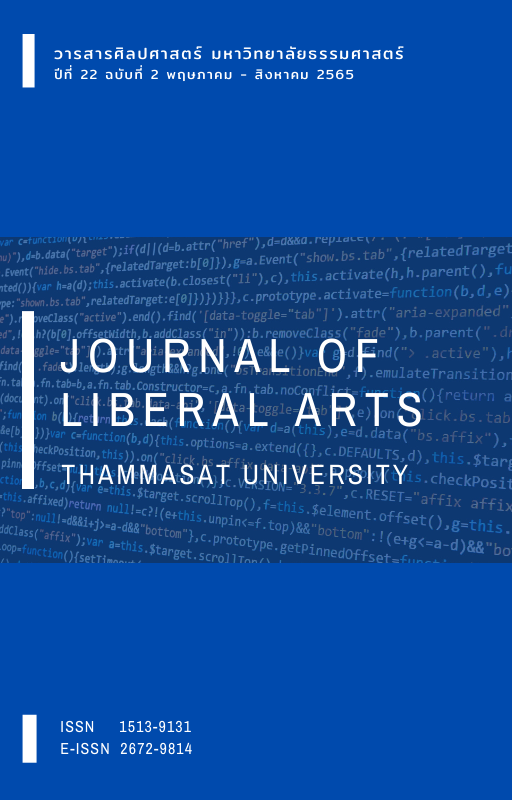การยืดเสียงพยัญชนะในอัลกุรอานตามหลักการอ่านตัจญ์วีด: การศึกษาค่าระยะเวลาทางกลสัทศาสตร์
Main Article Content
บทคัดย่อ
งานวิจัยนี้มีวัตถุประสงค์เพื่อศึกษาการยืดเสียงพยัญชนะภาษาอาหรับ ในการอัลกุรอานตามหลักตัจญ์วีดโดยการศึกษาครอบคลุมค่าระยะเวลาเฉลี่ยรวมของการยืดเสียงพยัญชนะ ค่าระยะเวลาเฉลี่ยการยืดเสียงพยัญชนะที่ปรากฏในตำแหน่งต่าง ๆ ของคำ และค่าระยะเวลาเฉลี่ยการยืดเสียงพยัญชนะที่ปรากฏนำหน้าเสียงสระ โดยการยืดเสียงดังกล่าวอยู่ภายใต้หลักการออกเสียงตัจญ์วีดซึ่งเป็นหลักการออกเสียงที่ผู้อ่าน อัลกุรอานต้องปฏิบัติตามอย่างเคร่งครัด ถึงแม้ว่าการยืดเสียงพยัญชนะหรือพยัญชนะเสียงยาวถือเป็นลักษณะสำคัญที่พบได้ในภาษาอาหรับซึ่งเป็นภาษาในตระกูลเซมิติกโดยส่งผลต่อการเปลี่ยนแปลงความหมายและลักษณะทางไวยากรณ์ของคำ แต่การยืดเสียงพยัญชนะตามหลักการ ออกเสียงตัจญ์วีดไม่ได้ส่งผลต่อการเปลี่ยนแปลงดังกล่าว แต่เพื่อทำให้ท่วงทำนองในการอ่านอัลกุรอานเป็นไปอย่างถูกต้อง แม่นยำ และน่าฟังมากยิ่งขึ้น ผลการวิจัยพบว่าเสียงพยัญชนะนาสิก [m:, n:] มีค่าระยะเวลาเฉลี่ยยาวที่สุด ในขณะที่พยัญชนกักไม่ก้อง [t:, k:] มีค่าระยเวลาเฉลี่ยสั้นที่สุด นอกจากนั้นยังพบว่าความแตกต่างของการยืดเสียงพยัญชนะนาสิก พยัญชนะเปิด และพยัญชนะรัวลิ้นที่เกิดในตำแหน่งต่าง ๆ ของคำแตกต่างกันอย่างมีนัยสำคัญทางสถิติ การทดสอบทางสถิติยังพบอีกว่าความแตกต่างของการยืดเสียงพยัญชนะเสียดแทรกที่ปรากฏร่วมนำหน้าเสียงสระมีความแตกต่างกันอย่างมีนัยสำคัญ งานวิจัยชิ้นนี้ยังแสดงให้เห็นหลักฐานที่สำคัญว่าการยืดเสียงพยัญชนะตามหลักตัจญ์วีดเป็นลักษณะเฉพาะและแตกต่างจากการยืดเสียงพยัญชนะในภาษาอาหรับมาตรฐาน ซึ่งผลการวิจัยจะเป็นประโยชน์อย่างยิ่งในการเรียนรู้หลักตัจญ์วีดและการเชื่อมโยงความรู้จากภาษาอาหรับมาตรฐานสู่ภาษาอาหรับในอัลกุรอาน
Downloads
Article Details

อนุญาตภายใต้เงื่อนไข Creative Commons Attribution-NonCommercial-NoDerivatives 4.0 International License.
เอกสารอ้างอิง
นดีม หะซะนี. (2556). ตัจวีดกะลามิรเราะฮ์มาน. กรุงเทพมหานคร.
สราวุฒิ ไกรเสม และ ยูเนียนสาสมีต้า สาเมาะ (2564). พยัญชนะเสียงยาวภาษาอาหรับในการอ่าน อัลกุรอาน: การวิเคราะห์ทางสัทวิทยาอัตภาค. วารสารมนุษยศาสตร์มหาวิทยาลัยนเรศวร, 18(3). 106-128.
สะอัด วารีย์. (2562). ตัจญ์วีดแบบง่าย. dasee. http://www.daasee.com/index.php
อับดุลอาซิซ สิเดะ และ ซาฟีอี อาดํา. (2558). การประทานและการรวบรวมอัลกุรอาน. วารสาร AL-NUR บัณฑิตวิทยาลัย, 2(10), 167-179.
Abramson, A. S. (1986). The perception of word-initial consonant length: Pattani Malay. Journal of the International Phonetic Association, 16(1), 8-16. doi:10.1017/S0025100300003054
Abramson, A. S. (1987). Word-initial consonant length in Pattani Malay. Proceedings of the 11th international congress of phonetic science, 6, 68-70.
Abramson, A. S. (1991). Amplitude as a cue to word-initial consonant length: Pattani Malay. Proceedings of the 12th International Congress of Phonetic Sciences, 3, 98-100.
Abramson, A. S. (2003). Acoustic cues to word-initial stop length in Pattani Malay. Proceedings of the 15th International Congress of Phonetic Sciences, 387-390.
Al-Ani, S. H. (1970). Arabic phonology: An acoustical and physiological investigation. Mouton.
Alsurf, S. (2012). The phonetics of Qur’ānic pharyngealised sounds: Acoustic and articulatory studies [Unpublished doctoral dissertation]. Macquarie University.
Al-Tamimi, F. Y. (2004). An experimental phonetic study of intervocalic singleton and geminate sonorants in Jordanian Arabic. Al-Arabiyya, 37-52.
Chang, W. (2000). Geminate vs. non-geminate consonants in Italian: evidence from a phonetic analysis. University of Pennsylvania Working Papers in Linguistics, 7(1), 53-63.
Embarki, M. (2013). Phonetics. In J. Owens (Ed.), The Oxford handbook of Arabic linguistics (pp. 23-44). Oxford University Press. doi:10.1093/oxfrodhb/9780199764136.013.0002
Goldsmith, J. A. (1990). Autosegmental & Metrical Phonology. Basil Blackwell.
Hamzah, H. (2013). The acoustics and perception of the word-initial singleton/geminate contrast in Kelantan Malay [Unpublished doctoral dissertation]. University of Melbourne.
Kawagoe, I. (2015). The phonology of sokuon, or geminate obstruents. In H. Kubozono (Ed.), The Handbook of Japanese Phonetics and Phonology (pp. 53-66). De Gruyter Mouton.
Kawahara, S. (2015).The phonetics of sokuon, or geminate obstruents. In H. Kubozono (Ed.), The Handbook of Japanese Phonetics and Phonology (pp. 43-78). De Gruyter Mouton.
Kaye, A. J. (2009). Arabic. In B. Comrie (Ed.), The world's major languages (pp. 560-577). Routledge.
Khattab, G. (2008).A phonetic study of gemination in Lebanese Arabic. 16th International Congress of Phonetic Sciences, 153-158. www.icphs2007.de
Khattab, G., & Al-Tamimi, J. (2014).Geminate timing in Lebanese Arabic: The relationship between phonetic timing and phonological structure. Laboratory Phonology, 5(2), 231-269. doi:10.1515/lp-2014-0009
Kubozono, H., Takeyasu, H., & Giriko, M. (2013). On the positional asymmetry of consonant gemination in Japanese loanwords Journal of East Asian Linguistics, 22(4), 339-371.
Ladefoged, P., & Maddieson, I. (1996). Sounds of the world's languages. Blackwell.
Lahiri, A., & Hankamer, J. (1988). The timing of geminate consonants. Journal of Phonetics, 16, 327-337.
Ohala, M. (2007). Experimental methods in the study of Hindi geminate consonants. In P. Beddor, M.-J. Solé & M. Ohala (Eds.), Experimental Approaches to Phonology (pp. 351-368). Oxford University Press.
Paramal, W. (1991). Long consonants in Pattani Malay: The result of word and phrase shortening [Unpublised master's thesis]. Mahidol University.
Rohman, S. (2552). ตัจญ์วีดเบื้องต้น. https://basictajweed.wordpress.com
Yeni-Komshian, G. H., Caramazza, A., & Preston, M. (1977). A study of voicing in Leabnese Arabic. Journal of Phonetics, 5, 35-48.


